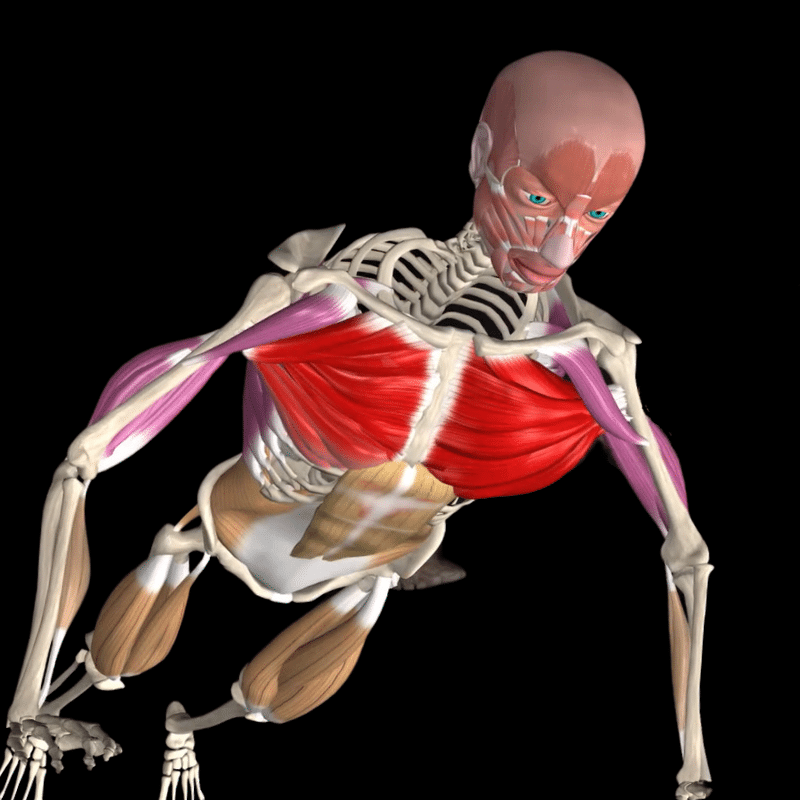Building muscles without weights might sound counterintuitive to many, but it’s entirely possible!
Over the last few years, more individuals have opted for home workouts due to the COVID-19 pandemic, vacations, or limited gym access. Given this growing trend towards at-home training, understanding how to build muscle by effectively using only your body weight is becoming increasingly essential.
In this Muscle and Motion article, we will provide a comprehensive guide on building muscles at home and which of your gym exercises you can replace.
Understanding muscle hypertrophy
To build muscle at home effectively, it’s crucial to grasp the fundamental elements of muscle development. Muscle growth, or hypertrophy, happens when the rate of protein synthesis exceeds that of protein breakdown in muscle tissues.
This leads to a net gain in protein, resulting in increased muscle mass.[1] The primary mechanisms behind muscle growth include:
- Mechanical Tension: Mechanical tension is the stress muscles endure during exercises. Take the bodyweight squat as an example: muscles face tension both when lowering (in the eccentric phase) and when lifting back up (in the concentric phase). When muscles experience sufficient mechanical tension, it deeply affects the muscle tissues, reaching even the individual muscle fibers. This initiates a cascade of chemical reactions that promote the production of proteins.[1]
- Metabolic Stress: Metabolic stress refers to the biochemical challenge faced by a muscle cell and its surrounding environment in producing energy and maintaining a life-sustaining balance. This biochemical challenge also initiates a chain of chemical reactions that encourage protein synthesis.[1]
- Muscle Damage: This pertains to alterations in the spatial arrangement of an individual muscle cell and damage to the connective tissues within and around the muscle. Typically, these damages are described as resulting from microscopic tears in structures within the muscle cell and groups of muscle cells or connective tissues. Such damages are believed to stimulate a series of chemical processes that support increased protein synthesis.[1,2]
All three processes directly or indirectly contribute to increased protein creation, known as muscle protein synthesis. Understanding these mechanisms is crucial for anyone aiming to enhance muscle growth effectively.
Can you build muscles with just bodyweight training?
Understanding muscle growth mechanisms makes it clearer how certain exercises can promote muscle development. Essentially, if muscles are subjected to sufficient stress and load, they will adapt and grow. The challenge with bodyweight training for many is ensuring a consistent and adequate load to stimulate muscle growth over an extended period without external weights. The key strategy is “progressive overload,” where the intensity of the exercises is gradually increased to challenge the muscles continually.
- Increasing volume: Performing more sets or increasing the number of training sessions per week can help in muscle growth.[3]
- Change levers and angles: Exercises can be done using both legs or a single leg. Experiment with leverage and Different angles to increase the load on the muscles.For example, inclined push-ups → decrease the inclination → push-ups with knee support → push-ups with straight legs →push-ups with a resistance band behind the back or with straps.
- Try exercise variations: Diversifying your routine with different versions of an exercise can stimulate muscles differently, encouraging growth. If you hit a plateau, consider modifying the exercise. For instance, switch to a single-leg or stiff-leg variation.
- Focus on prolonged contractions: Extending the duration of the exercise, especially the eccentric phase, can help enhance muscle growth by increasing the muscle’s time under tension.[4]
- Strategic bodyweight workouts: Organizing exercises by the specific muscle groups they target enhances effectiveness and helps to increase the load on the muscles.
If these strategies still don’t meet your needs, consider purchasing elastic bands. They can elevate the challenge of any exercise without requiring a full gym setup or weights.
Home exercises vs. gym exercises
While gym exercises often involve weights and machines, many bodyweight exercises can be done at home with similar benefits. For instance:
- Push-ups (Home) vs. Bench Press (Gym): Both target the chest and triceps.

- Pull-ups (Home) vs. Lat Pulldown (Gym): Both work on the back muscles. Don’t have access to a pull-up bar? Do an Inverted Row using a stable table.



In conclusion, building muscles without weights is not only feasible but can be highly effective with the right approach. If you’re eager to embark on this journey, we at Muscle and Motion have created multiple bodyweight exercise plans you can try. Dive into our program and experience firsthand the transformative power of strategic bodyweight training.
At Muscle and Motion, we believe that knowledge is power, and understanding the ‘why’ behind any exercise is essential for your long-term success.
Let the Strength Training App help you achieve your goals! Sign up for free.
Reference:
- Schoenfeld, B. J. (2010). The mechanisms of muscle hypertrophy and their application to resistance training. Journal of Strength and Conditioning Research, 24(10), 2857–2872.
- Schoenfeld, B. J. (2012). Does exercise-induced muscle damage play a role in skeletal muscle hypertrophy? Journal of Strength and Conditioning Research, 26(5), 1441–1453.
- Burd, N. A., West, D. W. D., Staples, A. W., Atherton, P. J., Baker, J. M., Moore, D. R., Holwerda, A. M., Parise, G., Rennie, M. J., Baker, S. K., & Phillips, S. M. (2010). Low-load high volume resistance exercise stimulates muscle protein synthesis more than high-load low volume resistance exercise in young men. PloS One, 5(8), e12033.
- Moore, D. R., Phillips, S. M., Babraj, J. A., Smith, K., & Rennie, M. J. (2005). Myofibrillar and collagen protein synthesis in human skeletal muscle in young men after maximal shortening and lengthening contractions. American Journal of Physiology. Endocrinology and Metabolism, 288(6), E1153–E1159.


